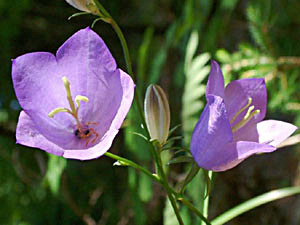
natural herbs
Harebell
Campanula persicifolia

Herb: Harebell
Latin name: Campanula persicifolia
Synonyms: Campanula crystallocalyx
Family: Campanulaceae (Bellflower Family)
Edible parts of Harebell:
Leaves - raw or cooked. Rich in vitamin C. A mild flavour, it is nice in salads and is liked by most people who try it. The plant forms over-wintering basal rosettes of leaves and thus provides a source of fresh leaves throughout the winter. The main problem with these leaves is that they are very narrow and it takes quite a lot of picking in order to obtain a reasonable quantity. Root - raw. Flowers - raw. A pleasant sweetness, and a very ornamental addition to mixed salads.Description of the plant:

Plant:
EvergreenPerennial

Height:
100 cm(3 1/4 foot)

Flowering:
June toAugust
Habitat of the herb:
Commons and open woods.Propagation of Harebell:
Seed - surface sow spring in a cold frame. The seed usually germinates in 2 - 4 weeks at 18°C. When they are large enough to handle, prick the seedlings out into individual pots and grow them on in a cold frame for at least their first winter. Plant them out into their permanent positions in late spring or early summer, after the last expected frosts. Basal cuttings in spring. Harvest the shoots when they are about 10 - 15cm long with plenty of underground stem. Pot them up into individual pots and keep them in light shade in a cold frame or greenhouse until they are rooting well. Plant them out in the summer. Division in spring or autumn. Very easy, larger clumps can be replanted direct into their permanent positions, though it is best to pot up smaller clumps and grow them on in a cold frame until they are rooting well. Plant them out in the summer or following spring.Cultivation of the herb:
Commons and open woods.Medicinal use of Harebell:
None knownKnown hazards of Campanula persicifolia:
None knownPlant information taken from the Plants For A Future.
